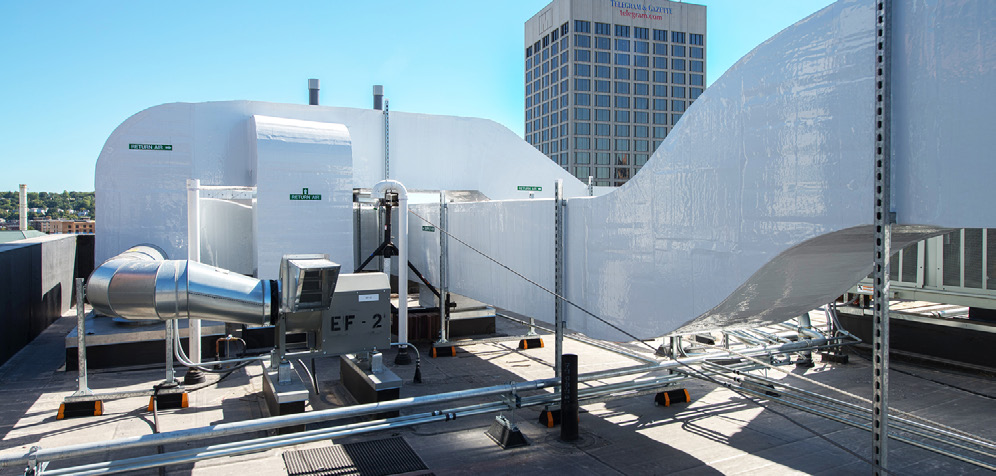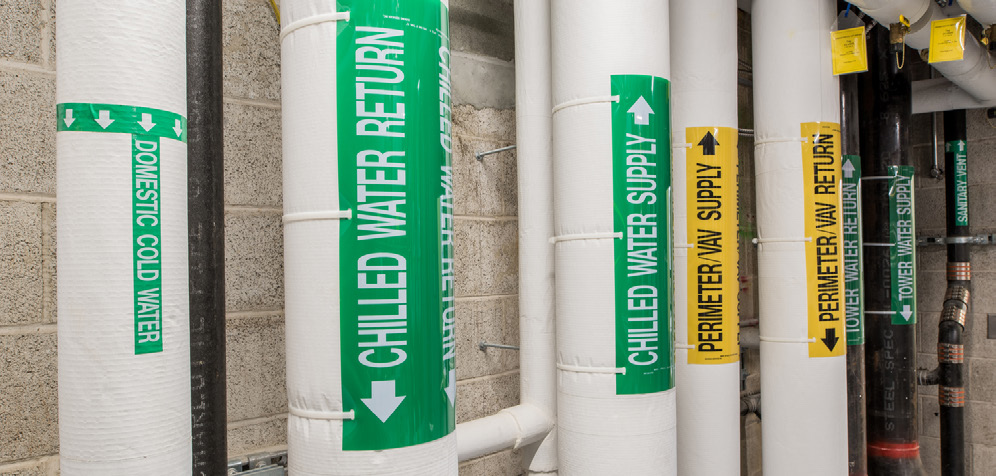As we return to our “new normal” post-COVID-19, building owners & operators need to be thinking about building system adjustments that can be employed in the wake of the pandemic’s aftermath.
Here are three M/E/P systems changes to consider making before end-users re-occupy your building.

Insights from Consigli’s Director of M/E/P Services Michael Culcasi & Sustainability Manager Steven Burke, LEED & WELL Faculty, CHPC
INCREASE BUILDING VENTILATION
Introducing fresh air into a building that has been minimally occupied or entirely empty for an extended period of time is a best practice with or without a viral pandemic. Before your building occupants return, consider conducting a building flush-out: open your outdoor air dampers to 100%, eliminate air recirculation, and temporarily turn off any heat exchange/energy recovery systems during COVID-19 episodes.
Open Outdoor Air Dampers: From a seasonal standpoint, timing is optimal for a building flush-out, specifically in the Northeast. With temperatures hovering around the 50º mark, temperature and humidity levels are moderate, meaning building systems will not require as much energy (and therefore, cost) to treat the air to bring it to an adequate level for the space.
Each building will have unique requirements and timing for an optimal flush-out, but in general, the following LEED flush-out calculation can be used as a guideline:
![]()
To achieve an optimal flush-out, HVAC operations settings shouldn’t be stopped, and adjustments shouldn’t be made until the full cycle has been completed.
If a full flush-out isn’t an option for your facility, ASHRAE recommends running your HVAC system for longer hours than usual—ideally, 24/7. For buildings that cannot commit to the energy costs associated with a full flush-out or peak air flow 24/7, systems can be switched to a higher speed at least two hours before occupancy and adjusted to a lower speed two hours after end-users leave. The system should remain operational at a lower speed overnight and on weekends.
For older buildings without modern HVAC systems, “flushing out” the space isn’t quite as simple. Building owners and operators should open all building windows and run bathroom exhaust fans for at least a few days in advance of occupancy, depending on your building size and how much exhaust can be pulled out via bathroom exhaust fans. Remember, this manual operation will require staffing commitments and an eye on the weather—open windows and rain/wind isn’t a good combination for any building.
Air Recirculation Systems: Air recirculation systems may reintroduce virus particles into buildings. For that reason, it is recommended that dampers are closed during COVID-19 episodes. This adjustment may result in thermal discomfort for occupants, but the importance of preventing contamination should be deemed priority over thermal comfort.
Heat Recovery/Energy Exchange: Under certain conditions, virus particles in extract air can re-enter the building, and heat recovery devices may reintroduce particles from the exhaust air side to the supply air side via leaks. Recovered air to air heat exchangers (i.e. rotors) may also be at
risk for substantial leaks in the event of poor design and maintenance. While we continue to learn about the spread and lifespan of the virus, exercising an abundance of caution should be considered a best practice.
CHANGE HVAC FILTERS

HVAC systems work by taking a percentage of recirculated interior air mixed with fresh air which, together, travels through a filter before being released into a building. These filters get dirty over time, collecting dust, debris and other airborne particles.
For most building types, changing your HVAC filters twice per year is considered a best practice. Installing new filters in your building won’t stop the spread of COVID-19, but dirty or ineffective filters can exacerbate underlying respiratory issues that make occupants more vulnerable to the virus. If you haven’t changed your filters lately, now is the time to do it (that goes for your home, too).
Additionally, consider increasing the Minimum Efficiency Rating Value (MERV) rating of your filters. The higher the rating, the more airborne particles it will capture. It is important to note, however, that these filters are more expensive and will require replacement more frequently.
FLUSH DOMESTIC WATER SYSTEMS

Domestic water systems that have sat stagnant for weeks or months during limited building occupancy can create ideal conditions for the growth of different types of bacteria such as legionella.
A flush-out of domestic water systems can help to combat the growth of legionella and other bacteria in your building’s water supply. These flush-outs should be conducted for a minimum of 15 minutes and within a few days of end-users returning to the building.
Fixtures to consider include (but are not limited to):
- Toilets
- Hand sinks
- Hot water heaters
- Water filtration systems (recommend changing filters, too)
- Ice machines
- Drinking fountains
There isn’t a one-size-fits-all solution to keeping your building healthy in the wake of COVID-19. Each building is different, and these tips should be used as guidance paired with knowledge of your own specific building systems. While these recommendations will help to minimize risk in your facility, they will not eliminate it. Encourage your end-users and occupants to follow CDC guidelines for hygiene and social distancing, which have proven to reduce the spread of the virus.
To access a full PDF of this information, click here:
COVID-19 White Paper Healthy Buildings_04.30.20
